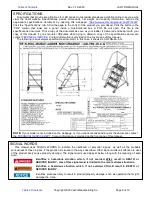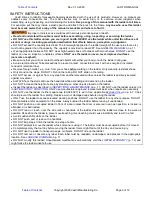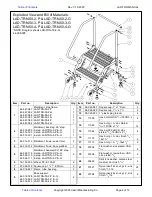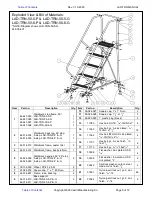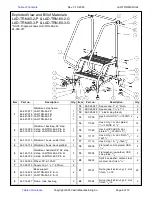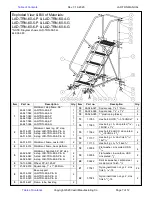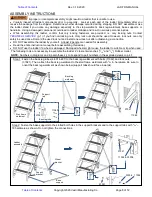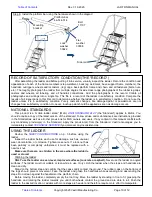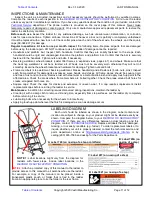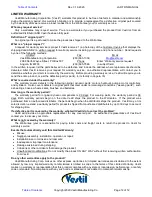
Rev. 3.19.2020
LAD-TRN MANUAL
Copyright 2020 Vestil Manufacturing Co.
Page 3 of 12
SAFETY INSTRUCTIONS
Vestil strives to identify foreseeable hazards associated with the use of its products. However, no manual can
address every conceivable risk. The most effective way to avoid injury is to exercise sound judgment when
assembling, using, inspecting, and maintaining this ladder.
Keep a copy of this manual with the ladder at all times.
For example, put the copy inside a plastic pouch and attach the pouch to the frame.
Anyone who uses this ladder
must be made aware that a copy of the manual is available and where to find it.
Improper or careless use could result in serious personal injuries or death.
•
Read and understand the entire manual before assembling, using, inspecting, or servicing the ladder.
•
DO NOT use this ladder unless you are in good health. NEVER use the ladder while under the influence of
alcohol or drugs, including prescription medication that affects balance, perception, or judgment.
•
DO NOT exceed the capacity/rated load. The total weight applied to the ladder (weight of the user plus tools, etc.)
must not be greater than the capacity. The capacity is provided on label 287. See
•
Wear appropriate footwear. DO NOT wear high-heeled shoes or footwear with smooth soles. DO NOT use the
ladder on uneven, sloped, or unstable surfaces.
ONLY use the ladder on even, level, improved surfaces
(concrete or asphalt).
•
Make sure that you will not contact overhead objects with either your body or with the ladder during use.
•
Avoid electrical shock! Take precautions to prevent contact, or possible contact, with an energized, insulated
conductor (electrical line).
•
Remove foreign matter, e.g. mud, from your shoes
before
walking on the ladder. Only wear slip-resistant shoes.
•
Only stand on the steps. DO NOT climb on the railing. DO NOT slide on the railing.
•
DO NOT access, or egress from, any step from another elevated surface unless the ladder is positively secured
against movement.
•
ALWAYS face the stairs and use the handrails while ascending and descending the ladder.
•
DO NOT increase the height of a step by standing on other objects placed on the ladder.
•
Inspect the ladder as described in
on p. 11. DO NOT use the ladder unless it is
. ONLY use manufacturer-approved replacement parts when repairs are necessary.
•
DO NOT use the ladder if either square cap (99-024-027) is worn. See applicable
should prevent the ladder from sliding. Replace worn or damaged caps before using the ladder.
•
ONLY use the ladder to access elevated working positions. DO NOT use the ladder for any other purpose. DO NOT
store materials and/or equipment on the steps. Always unload the ladder before leaving it unattended.
•
DO NOT position an occupied ladder in front of a door unless that door is secured in an open position, is locked, is
attended, or is barricaded.
•
DO NOT lean, or reach, over the side rails or handrails of the ladder. Position the ladder as close to the work as
possible. Reposition the ladder to prevent overreaching. Overreaching could cause instability and result in a fall.
•
Avoid sudden shifts while on the ladder.
•
DO NOT push, pull, or lean on the handrails.
•
DO NOT skip steps. Climb the ladder one step at a time.
•
DO NOT attempt to move the ladder while someone is using it. The ladder must be unoccupied before it is moved.
•
Completely empty the tool tray before moving the ladder. Items might fall out of the tray and cause injury.
•
DO NOT use the ladder to transport people or objects. DO NOT ride on the ladder.
•
DO NOT remove or obscure any label. Each label must be readable, undamaged, and present in the appropriate
location. See
LABELING DIAGRAM
on p. 11.
•
DO NOT modify this ladder! Unauthorized modifications automatically void the
(p. 12)
and
might make the ladder unsafe to use.


